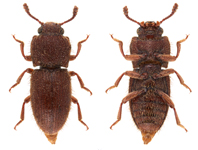Abstract
A new species, Daplasa medoga sp. nov., is described from Tibet, China. The new species can be distinguished morphologically from all other known Daplasa species by its male genitalia with a sagittate uncus and distally broadly crotched valvae. The validity of new species is well supported by the molecular phylogenetic analyses of one mitochondrial gene (COI) and two nuclear genes (EF-1α & RPS5), with a total length of 2,324 bp.
References
Chao, Z.L. (1985) A new species of Daplasa Moore (Lepidoptera: Lymantriidae). Acta Entomologica Sinica, 28 (2), 223–224.
Chao, Z.L. (2003) Lepidoptera Lymantriidae. Fauna Sinica, Insecta 30. Science Press, Beijing, 484 pp.
Hebert, P.D.N., Cywinska, A., Ball, S.L. & deWaard, J.R. (2003) Biological identifications through DNA barcodes. Proceedings of the Royal Society B: Biological Sciences, 270, 313–321.
https://doi.org/10.1098/rspb.2002.2218
Holloway, J.D. (1999) The moths of Borneo (part 5): family Lymantriidae. Malayan Nature Journal, 53, 1–188.
Kalyaanamoorthy, S., Minh, B.Q., Wong, T.K.F., von Haeseler, A. & Jermiin, L.S. (2017) ModelFinder: fast model selection for accurate phylogenetic estimates. Nature Methods, 14, 587–589.
https://doi.org/10.1038/nmeth.4285
Kimura, M. (1980) A simple method for estimating evolutionary rates of base substitutions through comparative studies of nucleotide sequences. Journal of molecular evolution, 16 (2), 111–120.
https://doi.org/10.1007/BF01731581
Kishida, Y. (1993) Lymantriidae. Moths of Nepal, Part 2. Tinea, 13 (Supplement 3), 80–95.
Moore, F. (1879) Descriptions of new Indian Lepidopterous Insects from the collection of the late Mr. W. S. Atkinson. Heterocera Part I. Taylor & Francis, London, 88 pp.
Nguyen, L.T., Schmidt, H.A., von Haeseler, A. & Minh, B.Q. (2015) IQ-TREE: a fast and effective stochastic algorithm for estimating maximum-likelihood phylogenies. Molecular Biology and Evolution, 32, 268–274.
https://doi.org/10.1093/molbev/msu300
Pang, X.Y., Rindos, M., Kishida, Y. & Wang, H.S. (2019) Review of the genus Daplasa Moore (Lepidoptera, Erebidae, Lymantriinae) from China, with description of new species. Zootaxa, 4695 (6), 577–585.
https://doi.org/10.11646/zootaxa.4695.6.8
Ronquist, F., Teslenko, M., van der Mark, P., Ayres, D.L., Darling, A., Höhna, S., Larget, B., Liu, L., Suchard, M.A. & Huelsenbeck, J.P. (2012) MrBayes 3.2: efficient Bayesian phylogenetic inference and model choice across a large model space. Systematic Biology, 61 (3), 539–542.
https://doi.org/10.1093/sysbio/sys029
Sudhir, K., Glen, S., Michael, L., Christina, K. & Koichiro, T. (2018) MEGA X: molecular evolutionary genetics analysis across computing platforms. Molecular Biology & Evolution, 35 (6), 1547–1549.
https://doi.org/10.1093/molbev/msy096
Swinhoe, C. (1904) New species of Eastern, Australian and African Heterocera in the national collection. Transactions of the entomological Society of London, (1), 139–158. [https://www.biodiversitylibrary.org/page/14684340#page/182/mode/1up]
https://doi.org/10.1111/j.1365-2311.1904.tb02743.x
Wahlberg, N. & Wheat, C.W. (2008) Genomic outposts serve the phylogenomic pioneers: designing novel nuclear markers for genomic DNA extractions of lepidoptera. Systematic Biology, 57 (2), 231–242.
https://doi.org/10.1080/10635150802033006
Wang, H.S., Fan, X.L., Owada, M., Wang, M. & Nylin, S. (2014) Phylogeny, systematics and biogeography of the genus Panolis (Lepidoptera: Noctuidae) based on morphological and molecular evidence. PLoS ONE, 9 (3), e90598.
https://doi.org/10.1371/journal.pone.0090598Wang, H.S., Wahlberg, N., Holloway, J.D., Bergsten J., Fan X.L., Janzen, D.H., Hallwachs, W., Wen, L.J., Wang, M. & Nylin, S. (2015) Molecular phylogeny of Lymantriinae (Lepidoptera, Noctuoidea, Erebidae) inferred from eight gene regions. Cladistics, 31 (6), 579–592.
https://doi.org/10.1111/cla.12108
Wang, H.S, Xiong, W. & Wang, M. (2010) Two new species of the genus Longipenis (Lepidoptera: Lecithoceridae) from China. Florida Entomologist, 93 (3), 352–356.
https://doi.org/10.1653/024.093.0305


